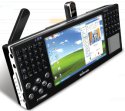MIDs to outsell netbooks in five years?
Sep 24, 2008 — by Eric Brown — from the LinuxDevices Archive — 3 views [Updated Nov. 26] — Linux stacks such as Moblin and Maemo will dominate the mobile Internet device (MID) market, says ABI Research. The firm expects Moblin to take 42 percent of the market in 2013, when it expects 86 million Linux-enabled MIDs to ship.
[Updated Nov. 26] — Linux stacks such as Moblin and Maemo will dominate the mobile Internet device (MID) market, says ABI Research. The firm expects Moblin to take 42 percent of the market in 2013, when it expects 86 million Linux-enabled MIDs to ship.
(Click for larger view of the WiBrain i1 MID)
The report, “Open source operating systems in Mobile Internet Devices,” is part of a larger report on what ABI calls ultra-mobile devices (UMDs), which it defines as covering MIDs, ultra-mobile PCs, and netbooks (listed by size, in ascending order). The UMD report predicts that these Internet-ready devices, which target the space between notebooks and smartphones, will jump from 10 million units in 2008 to over 200 million in 2013, representing $27 billion in sales. Although smaller than the mobile phone market in terms of unit sales, the 200 million number is roughly the same as that ABI predicts for the PC laptop market at that time.
Netbooks currently represent 90 percent of the “UMD” market, but will fall by 2013 to a “distant second” behind MIDs, which are expected to control 68 percent of the market. The mid-sized UMPCs, meanwhile, are expected to languish as a niche category, says ABI.
ABI forecasts that Linux will take the “lion's share” of the MID market, although it does not reveal exact percentages. ABI does, however, state that the Linux MID segment will primarily be limited to three platforms. After Moblin's 42 percent share will come Nokia's Maemo, which runs on is Internet Tablets, including the N810. The LiMo Foundation's mobile-phone oriented LiMo Platform, which is a more open-ended middleware specification instead of a distribution, will come in third.
 Lenovo MID prototype |
The Linux MID projections of 86 million devices in 2013 are higher than those listed in an earlier MID study released by ABI this year, which pegged the number at 50 million. Intel coined the term “MID” in April of 2007 when it launched the MID concept as a platform for running its Intel Atom processor. Atom-based MIDs are just now beginning to be unveiled, with some early teaser announcements such as the Atom-based WiBrain i1 (pictured above). A number of MIDs are expected to ship over the next few months, including the Lenovo prototype pictured at right.
Using a broader definition for the format, Nokia has been shipping MIDs for several years now with its Maemo-based N800 and N810 Internet Tablets. Nokia recently tipped the news that it plans to add 3G/HSPA capabilities to a Texas Instruments OMAP3-optimized Maemo 5 release targeted at the tablets.
As part of its master plan for Atom and the MID market, Intel sponsored the open source Moblin.org, which recently announced version 2.0 of its MID-targeted Moblin stack. Moblin comprises a Linux kernel, UI framework, browser, multimedia framework, and embedded Linux image creation tools, along with developer resources such as documentation, mailing lists, and an IRC channel.
Meanwhile, says ABI, Microsoft will trail in the MID category, but still offer “stiff competition” with Windows Vista, XP, and CE-based MIDs. Another recent study on MIDs by Forward Concepts also forecast that Linux will be a top OS in the segment, pegging total MID shipments as growing from 305,000 units in 2008 to 39.6 million units in 2012.
Stated ABI VP Stuart Carlaw, “One of the chief reasons for the projected growth of Moblin is that the tight alignment between hardware and software will be an incredibly important factor in this market. Moblin's market share will be tightly aligned to the share of the market that Intel's Atom solution gains.”
Availability
ABI's “Open source operating systems in Mobile Internet Devices” study should be available here, and the larger study on “UMDs” should be here.
This article was originally published on LinuxDevices.com and has been donated to the open source community by QuinStreet Inc. Please visit LinuxToday.com for up-to-date news and articles about Linux and open source.